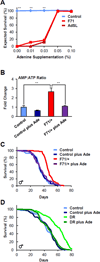Adenosine nucleotide biosynthesis and AMPK regulate adult life span and mediate the longevity benefit of caloric restriction in flies
- PMID: 23312286
- PMCID: PMC3614013
- DOI: 10.1016/j.cmet.2012.12.006
Adenosine nucleotide biosynthesis and AMPK regulate adult life span and mediate the longevity benefit of caloric restriction in flies
Abstract
A common thread among conserved life span regulators lies within intertwined roles in metabolism and energy homeostasis. We show that heterozygous mutations of AMP biosynthetic enzymes extend Drosophila life span. The life span benefit of these mutations depends upon increased AMP:ATP and ADP:ATP ratios and adenosine monophosphate-activated protein kinase (AMPK). Transgenic expression of AMPK in adult fat body or adult muscle, key metabolic tissues, extended life span, while AMPK RNAi reduced life span. Supplementing adenine, a substrate for AMP biosynthesis, to the diet of long-lived AMP biosynthesis mutants reversed life span extension. Remarkably, this simple change in diet also blocked the prolongevity effects of dietary restriction. These data establish AMP biosynthesis, adenosine nucleotide ratios, and AMPK as determinants of adult life span; provide a mechanistic link between cellular anabolism and energy sensing pathways; and indicate that dietary adenine manipulations might alter metabolism to influence animal life span.
Copyright © 2013 Elsevier Inc. All rights reserved.
Figures







Comment in
-
Tipping the energy balance toward longevity.Cell Metab. 2013 Jan 8;17(1):5-6. doi: 10.1016/j.cmet.2012.11.011. Cell Metab. 2013. PMID: 23312278
Similar articles
-
Sensing of energy and nutrients by AMP-activated protein kinase.Am J Clin Nutr. 2011 Apr;93(4):891S-6. doi: 10.3945/ajcn.110.001925. Epub 2011 Feb 16. Am J Clin Nutr. 2011. PMID: 21325438 Review.
-
Calorie restriction: is AMPK a key sensor and effector?Physiology (Bethesda). 2011 Aug;26(4):214-24. doi: 10.1152/physiol.00010.2011. Physiology (Bethesda). 2011. PMID: 21841070 Free PMC article. Review.
-
AMP-activated protein kinase protects against anoxia in Drosophila melanogaster.Comp Biochem Physiol A Mol Integr Physiol. 2017 Dec;214:30-39. doi: 10.1016/j.cbpa.2017.09.006. Epub 2017 Sep 12. Comp Biochem Physiol A Mol Integr Physiol. 2017. PMID: 28916374
-
The GID ubiquitin ligase complex is a regulator of AMPK activity and organismal lifespan.Autophagy. 2020 Sep;16(9):1618-1634. doi: 10.1080/15548627.2019.1695399. Epub 2019 Dec 3. Autophagy. 2020. PMID: 31795790 Free PMC article.
-
Genetic perturbation of AMP biosynthesis extends lifespan and restores metabolic health in a naturally short-lived vertebrate.Dev Cell. 2023 Aug 7;58(15):1350-1364.e10. doi: 10.1016/j.devcel.2023.05.015. Epub 2023 Jun 14. Dev Cell. 2023. PMID: 37321215
Cited by
-
One-carbon metabolism: an aging-cancer crossroad for the gerosuppressant metformin.Aging (Albany NY). 2012 Dec;4(12):894-8. doi: 10.18632/aging.100523. Aging (Albany NY). 2012. PMID: 23525940 Free PMC article.
-
Molecular inhibition of RAS signalling to target ageing and age-related health.Dis Model Mech. 2022 Oct 1;15(10):dmm049627. doi: 10.1242/dmm.049627. Epub 2022 Sep 16. Dis Model Mech. 2022. PMID: 36111627 Free PMC article. Review.
-
Regulation of the one carbon folate cycle as a shared metabolic signature of longevity.Nat Commun. 2021 Jun 9;12(1):3486. doi: 10.1038/s41467-021-23856-9. Nat Commun. 2021. PMID: 34108489 Free PMC article.
-
Metabolism, homeostasis, and aging.Trends Endocrinol Metab. 2023 Mar;34(3):158-169. doi: 10.1016/j.tem.2023.01.003. Epub 2023 Jan 20. Trends Endocrinol Metab. 2023. PMID: 36681595 Free PMC article. Review.
-
Yorkie Functions at the Cell Cortex to Promote Myosin Activation in a Non-transcriptional Manner.Dev Cell. 2018 Aug 6;46(3):271-284.e5. doi: 10.1016/j.devcel.2018.06.017. Epub 2018 Jul 19. Dev Cell. 2018. PMID: 30032991 Free PMC article.
References
-
- Artal-Sanz M, Tavernarakis N. Mechanisms of aging and energy metabolism in Caenorhabditis elegans. IUBMB Life. 2008;60:315–322. - PubMed
-
- Berrington A, Partridge S, Bates C, Ridgway E. Community-sampling of blood in suspected meningococcal infection. Lancet. 1996;348:1103–1104. - PubMed
-
- Broughton SJ, Piper MD, Ikeya T, Bass TM, Jacobson J, Driege Y, Martinez P, Hafen E, Withers DJ, Leevers SJ, et al. Longer lifespan, altered metabolism, and stress resistance in Drosophila from ablation of cells making insulin-like ligands. Proc Natl Acad Sci U S A. 2005;102:3105–3110. - PMC - PubMed
Publication types
MeSH terms
Substances
Grants and funding
LinkOut - more resources
Full Text Sources
Other Literature Sources
Molecular Biology Databases
Research Materials

